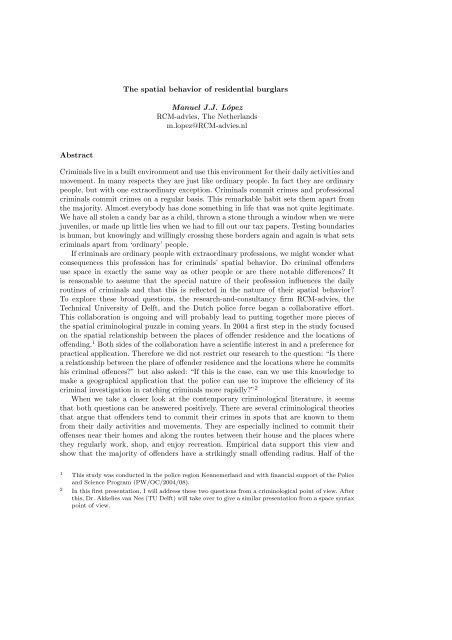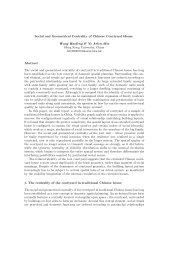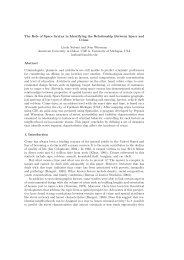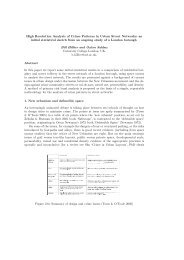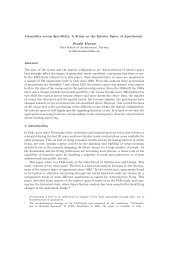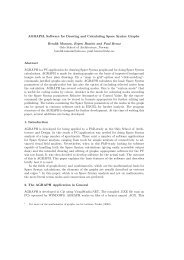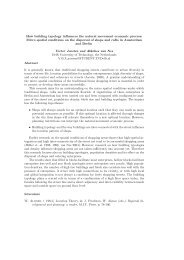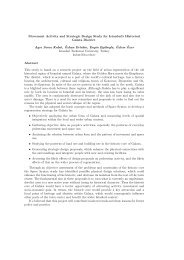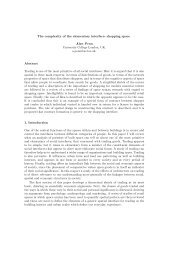The spatial behavior of residential burglars Manuel J.J. ... - TU Delft
The spatial behavior of residential burglars Manuel J.J. ... - TU Delft
The spatial behavior of residential burglars Manuel J.J. ... - TU Delft
You also want an ePaper? Increase the reach of your titles
YUMPU automatically turns print PDFs into web optimized ePapers that Google loves.
<strong>The</strong> <strong>spatial</strong> <strong>behavior</strong> <strong>of</strong> <strong>residential</strong> <strong>burglars</strong><br />
<strong>Manuel</strong> J.J. López<br />
RCM-advies, <strong>The</strong> Netherlands<br />
m.lopez@RCM-advies.nl<br />
Abstract<br />
Criminals live in a built environment and use this environment for their daily activities and<br />
movement. In many respects they are just like ordinary people. In fact they are ordinary<br />
people, but with one extraordinary exception. Criminals commit crimes and pr<strong>of</strong>essional<br />
criminals commit crimes on a regular basis. This remarkable habit sets them apart from<br />
the majority. Almost everybody has done something in life that was not quite legitimate.<br />
We have all stolen a candy bar as a child, thrown a stone through a window when we were<br />
juveniles, or made up little lies when we had to fill out our tax papers. Testing boundaries<br />
is human, but knowingly and willingly crossing these borders again and again is what sets<br />
criminals apart from ‘ordinary’ people.<br />
If criminals are ordinary people with extraordinary pr<strong>of</strong>essions, we might wonder what<br />
consequences this pr<strong>of</strong>ession has for criminals’ <strong>spatial</strong> <strong>behavior</strong>. Do criminal <strong>of</strong>fenders<br />
use space in exactly the same way as other people or are there notable differences? It<br />
is reasonable to assume that the special nature <strong>of</strong> their pr<strong>of</strong>ession influences the daily<br />
routines <strong>of</strong> criminals and that this is reflected in the nature <strong>of</strong> their <strong>spatial</strong> <strong>behavior</strong>?<br />
To explore these broad questions, the research-and-consultancy firm RCM-advies, the<br />
Technical University <strong>of</strong> <strong>Delft</strong>, and the Dutch police force began a collaborative effort.<br />
This collaboration is ongoing and will probably lead to putting together more pieces <strong>of</strong><br />
the <strong>spatial</strong> criminological puzzle in coming years. In 2004 a first step in the study focused<br />
on the <strong>spatial</strong> relationship between the places <strong>of</strong> <strong>of</strong>fender residence and the locations <strong>of</strong><br />
<strong>of</strong>fending. 1 Both sides <strong>of</strong> the collaboration have a scientific interest in and a preference for<br />
practical application. <strong>The</strong>refore we did not restrict our research to the question: “Is there<br />
a relationship between the place <strong>of</strong> <strong>of</strong>fender residence and the locations where he commits<br />
his criminal <strong>of</strong>fences?” but also asked: “If this is the case, can we use this knowledge to<br />
make a geographical application that the police can use to improve the efficiency <strong>of</strong> its<br />
criminal investigation in catching criminals more rapidly?” 2<br />
When we take a closer look at the contemporary criminological literature, it seems<br />
that both questions can be answered positively. <strong>The</strong>re are several criminological theories<br />
that argue that <strong>of</strong>fenders tend to commit their crimes in spots that are known to them<br />
from their daily activities and movements. <strong>The</strong>y are especially inclined to commit their<br />
<strong>of</strong>fenses near their homes and along the routes between their house and the places where<br />
they regularly work, shop, and enjoy recreation. Empirical data support this view and<br />
show that the majority <strong>of</strong> <strong>of</strong>fenders have a strikingly small <strong>of</strong>fending radius. Half <strong>of</strong> the<br />
1 This study was conducted in the police region Kennemerland and with financial support <strong>of</strong> the Police<br />
and Science Program (PW/OC/2004/08).<br />
2 In this first presentation, I will address these two questions from a criminological point <strong>of</strong> view. After<br />
this, Dr. Akkelies van Nes (<strong>TU</strong> <strong>Delft</strong>) will take over to give a similar presentation from a space syntax<br />
point <strong>of</strong> view.
424 <strong>Manuel</strong> J.J. López<br />
hold-ups in Amsterdam take place within a range <strong>of</strong> 2.6 kilometers from the home <strong>of</strong> the<br />
<strong>of</strong>fender (Van Koppen et al. 2000). <strong>The</strong> police can exploit these scientific insights and<br />
use them to catch <strong>of</strong>fenders more rapidly and more efficiently. This form <strong>of</strong> intelligenceled<br />
policing is also called geographic pr<strong>of</strong>iling. In Canada, the U.S., and Great Britain,<br />
geographic pr<strong>of</strong>iling has been applied successfully by several police forces and has led to<br />
several pr<strong>of</strong>iling techniques and (associated) s<strong>of</strong>tware.<br />
1. Criminological theories<br />
Geographic pr<strong>of</strong>iling has its scientific basis in environmental criminology and - more specifically<br />
- routine activity theory (Felson and Cohen 1998) and crime pattern theory (Brantingham<br />
and Brantingham 1981; 1993; 1995). <strong>The</strong>se theories argue that criminal <strong>of</strong>fenders<br />
commit their crimes in spots and places that are familiar to them from daily routine.<br />
<strong>The</strong>se spots are along the routes between their homes and the places they regularly work,<br />
shop, and enjoy recreation. On the way to his local supermarket, a <strong>residential</strong> burglar<br />
looks at the houses he passes and gets an idea <strong>of</strong> available attractive targets. Every time<br />
he takes this route, he gets to know the area better. He learns, for example, in which<br />
houses nobody is present during the day, which houses are poorly protected and which<br />
ones house wealthy residents. “Opportunity spaces” arise on the basis <strong>of</strong> this knowledge.<br />
<strong>The</strong>se are spots within the <strong>of</strong>fender’s <strong>spatial</strong> experience that he assesses as attractive. <strong>The</strong><br />
home <strong>of</strong> the <strong>of</strong>fender generally forms a central place in his <strong>spatial</strong> experience (“awareness<br />
space”). Just like non-delinquents, delinquents spend most <strong>of</strong> their time in and around<br />
their homes 3 . <strong>The</strong> home is, for most <strong>of</strong> us, both geographically and socially the most central<br />
spot in our life and forms our geographical operating base. For the <strong>of</strong>fender, the home<br />
is generally the start and/or end <strong>of</strong> his criminal journey. This explains why the criminal<br />
<strong>of</strong>fender commits his crimes in the proximity <strong>of</strong> his home: in spots that are known to him<br />
and considered to be attractive.<br />
<strong>The</strong> fact that criminals generally commit their <strong>of</strong>fences in the proximity <strong>of</strong> their homes<br />
is also well supported by empirical data. Empirical studies do, however, call our attention<br />
to some important points. Some <strong>of</strong>fenders do not have a steady home address. Moreover,<br />
there is a category <strong>of</strong> <strong>of</strong>fenders who are extremely mobile and commit their <strong>of</strong>fences everywhere<br />
but in the proximity <strong>of</strong> their homes (Canter and Larkin 1993; Wiles and Costello<br />
2000). <strong>The</strong>y do not commit their <strong>of</strong>fences near their homes, but in the proximity <strong>of</strong> other<br />
geographical anchor points such as their workplace, café, the house <strong>of</strong> a relative or friend<br />
(Rengert and Wasilchick 2000), or somewhere in the inner city (Shaw and McKay 1942).<br />
With regard to numbers, these specific categories <strong>of</strong> <strong>of</strong>fenders are significant, but nevertheless,<br />
a minority. Finally, empirical studies show that the distance <strong>of</strong> travel (the so-called<br />
“range <strong>of</strong> operation”) <strong>of</strong> an <strong>of</strong>fender is everything but constant. <strong>The</strong> size <strong>of</strong> this range <strong>of</strong><br />
operation depends on the characteristics <strong>of</strong> the <strong>of</strong>fender, the <strong>of</strong>fense type, the characteristics<br />
<strong>of</strong> the <strong>spatial</strong> environment, and the prevalent modes <strong>of</strong> personal transportation.<br />
Criminological theories not only suggest a range <strong>of</strong> operation, but also some other<br />
aspects that influence the relationship between the place <strong>of</strong> residence and places <strong>of</strong> <strong>of</strong>fending.<br />
<strong>The</strong> first <strong>of</strong> these aspects is known as the principle <strong>of</strong> “distance decay.” This principle<br />
suggests that within a radius, the number <strong>of</strong> <strong>of</strong>fences will decrease exponentially with<br />
the increase <strong>of</strong> travel distance. At the centre <strong>of</strong> the radius, directly around the <strong>of</strong>fender’s<br />
3 On average, we spend three quarters <strong>of</strong> our time in and around our home (Ministry <strong>of</strong> VROM 2000,<br />
pg. 15).
<strong>The</strong> <strong>spatial</strong> <strong>behavior</strong> <strong>of</strong> <strong>residential</strong> <strong>burglars</strong> 425<br />
Figure 199: “Awareness space” and “opportunity space”<br />
home, there is a reduced likelihood <strong>of</strong>f <strong>of</strong>fending (Turner 1969). <strong>The</strong> people who live in this<br />
area (also called the “buffer zone”) are more likely to know the <strong>of</strong>fender than people who<br />
live a little farther away so there is a higher risk <strong>of</strong> recognition. Several studies mention<br />
the importance <strong>of</strong> travel direction (e.g. Godwin 2000; Lundrigan and Canter 2001) and<br />
all environmental criminological theories also point to <strong>spatial</strong> and physical characteristics<br />
if the built environment is to be taken into account. In sum, criminological theory recognizes<br />
five parameters that explain the <strong>spatial</strong> relationship between an <strong>of</strong>fender’s home<br />
and places <strong>of</strong> <strong>of</strong>fending. Four parameters - range <strong>of</strong> operation, distance decay, buffer zone<br />
and travel direction - are related to the awareness space <strong>of</strong> the <strong>of</strong>fender. One parameter -<br />
<strong>spatial</strong> and physical characteristics <strong>of</strong> the built environment - represents the opportunity<br />
space <strong>of</strong> the <strong>of</strong>fender.<br />
2. <strong>The</strong> study<br />
<strong>The</strong> parameters that give a theoretical explanation for the <strong>spatial</strong> relationship between<br />
an <strong>of</strong>fender’s home and places <strong>of</strong> <strong>of</strong>fending can easily be tested when we have a database<br />
<strong>of</strong> known <strong>of</strong>fenders, locations <strong>of</strong> their home bases, and locations <strong>of</strong> their crimes. Such a<br />
database not only allows us to test the validity <strong>of</strong> the parameters, but also the validity<br />
<strong>of</strong> the different pr<strong>of</strong>iling techniques that use these parameters to identify the area within<br />
which we have the largest probability <strong>of</strong> finding the <strong>of</strong>fender’s home base. Thus, a database<br />
was constructed with information <strong>of</strong> all <strong>residential</strong> <strong>burglars</strong> who lived in the police region<br />
<strong>of</strong> Kennemerland and who were known to have committed at least 5 burglaries in a period<br />
<strong>of</strong> six years (1998 - 2004). <strong>The</strong> database contained information on the <strong>of</strong>fender’s (present<br />
and previous) home addresses and the addresses <strong>of</strong> the <strong>residential</strong> burglaries for which<br />
they were convicted.<br />
<strong>The</strong> study was based on a sample <strong>of</strong> 20 <strong>residential</strong> <strong>burglars</strong>. All <strong>of</strong> these <strong>burglars</strong> lived<br />
in the police region <strong>of</strong> Kennemerland during the period <strong>of</strong> <strong>of</strong>fending and were convicted <strong>of</strong>
426 <strong>Manuel</strong> J.J. López<br />
Figure 200: Range <strong>of</strong> operation and buffer zone<br />
at least five burglary <strong>of</strong>fences that were committed between 1998 and 2004. When we look<br />
at the sample, we see that none <strong>of</strong> the <strong>of</strong>fenders were specialists in the sense that they did<br />
not limit their criminal acts to <strong>residential</strong> burglary. <strong>The</strong>y were all male and between the<br />
ages <strong>of</strong> 21 and 43. <strong>The</strong> mean age was 31.8 (S.D. = 0.6). Seven <strong>of</strong>fenders were registered<br />
by the police as habitual <strong>of</strong>fenders, one was an alcoholic and one was a drug addict. <strong>The</strong><br />
average number <strong>of</strong> burglary <strong>of</strong>fences by one <strong>of</strong>fender was 11, with a minimum <strong>of</strong> 5 and a<br />
maximum <strong>of</strong> 19 (S.D. = 3.9). Half <strong>of</strong> the <strong>of</strong>fenders (10) were born in Kennemerland and<br />
the other half were born elsewhere in <strong>The</strong> Netherlands (8) or abroad (2).<br />
A minimum <strong>of</strong> five maps was made for each <strong>of</strong>fender. <strong>The</strong> first map showed the different<br />
home addresses <strong>of</strong> the <strong>of</strong>fender during his lifetime. A distinction was made between the<br />
<strong>of</strong>fender’s home address before, during and after the period <strong>of</strong> <strong>of</strong>fending. <strong>The</strong> second<br />
map marked the locations <strong>of</strong> the burglary <strong>of</strong>fences and the remaining maps gave different<br />
representations <strong>of</strong> the relationship between the <strong>of</strong>fender’s home and burglary locations.<br />
3. Range <strong>of</strong> operation<br />
<strong>The</strong> first step in the study was testing the hypothesis about the range <strong>of</strong> operation.<br />
When we know both the location <strong>of</strong> the <strong>of</strong>fender’s home base and the location <strong>of</strong> his<br />
<strong>of</strong>fenses, we can easily determine the range <strong>of</strong> operation by measuring the longest straightline<br />
distance between the home location and <strong>of</strong>fence locations. <strong>The</strong> so-called buffer zone<br />
can be determined in the same fashion, by measuring the shortest straight-line distance<br />
between the home location and <strong>of</strong>fence locations. Both the range <strong>of</strong> operation and the<br />
buffer zone can be represented on a map, by drawing both distances around the home<br />
location with a pair <strong>of</strong> compasses (Figure 200). When we reverse this procedure and draw<br />
the longest straight-line distance not around the location <strong>of</strong> the <strong>of</strong>fender’s home but around<br />
the locations <strong>of</strong> his <strong>of</strong>fences, we see that the <strong>of</strong>fender’s home base is in the area <strong>of</strong> the<br />
biggest overlap (Figure 201).<br />
If we both know the location <strong>of</strong> the <strong>of</strong>fences and the distance <strong>of</strong> the range <strong>of</strong> operation,<br />
we can be 100% accurate in defining the area in which we can expect the <strong>of</strong>fender’s
<strong>The</strong> <strong>spatial</strong> <strong>behavior</strong> <strong>of</strong> <strong>residential</strong> <strong>burglars</strong> 427<br />
Figure 201: Defining the search area<br />
home base. However, criminal investigation is not always successful and most crimes are<br />
not solved. 4 <strong>The</strong> police may have indications that certain <strong>of</strong>fences are committed by the<br />
same <strong>of</strong>fender (e.g. through DNA or other clues), but may not know the identity <strong>of</strong> the<br />
<strong>of</strong>fender and his range <strong>of</strong> operation. For such cases we have a couple <strong>of</strong> techniques that<br />
can help. Canter and Larkin (1993) measure the maximum distance <strong>of</strong> <strong>of</strong>fence locations<br />
within a crime series as the range <strong>of</strong> operation. This method might seem arbitrary, but it<br />
is based on the empirical finding that the maximum distance <strong>of</strong> <strong>of</strong>fence locations usually<br />
closely matches the longest straight-line distance between the home location and <strong>of</strong>fence<br />
location (the range <strong>of</strong> operation). Van Koppen et al. (2000) present another solution. <strong>The</strong>y<br />
measure all distances between the home and <strong>of</strong>fence locations for every known <strong>of</strong>fender,<br />
<strong>of</strong>fence type, and geographic area. <strong>The</strong>n, the median <strong>of</strong> these distances is calculated. <strong>The</strong><br />
resulting value is the range <strong>of</strong> operation <strong>of</strong> all <strong>of</strong>fenders within that geographic area.<br />
Both methods have their pros and cons. <strong>The</strong> method <strong>of</strong> Canter and Larkin is <strong>of</strong>fender<br />
specific and therefore does justice to the variations <strong>of</strong> mobility <strong>of</strong> the different individual<br />
<strong>of</strong>fenders. This method also <strong>of</strong>ten succeeds in identifying the correct search area (the area<br />
in which the home location <strong>of</strong> the <strong>of</strong>fender is suspected), but in some cases this area is<br />
so large that it has no additional value for the criminal investigation. <strong>The</strong> method <strong>of</strong> Van<br />
Koppen et al. is not <strong>of</strong>fender specific as it chooses one range <strong>of</strong> operation for all <strong>of</strong>fenders<br />
<strong>of</strong> a certain <strong>of</strong>fense type in a given geographic area. <strong>The</strong> advantage <strong>of</strong> this approach is<br />
that the range <strong>of</strong> operation that will be used for criminal investigation is never too big.<br />
It always produces search areas that are small; thus, they <strong>of</strong>fer additional value for the<br />
criminal investigation. However, the method also has two major disadvantages. <strong>The</strong> first<br />
disadvantage is the fact that it is based on the incorrect assumption that the radius in<br />
which he commits 50 percent <strong>of</strong> his <strong>of</strong>fences can identify the <strong>of</strong>fender’s range <strong>of</strong> operation. 5<br />
<strong>The</strong>re is also the disadvantage that the method does insufficient justice to the fact that<br />
different <strong>of</strong>fenders most <strong>of</strong>ten have different ranges <strong>of</strong> operation. Given the disadvantages <strong>of</strong><br />
both methods, this study developed an alternative approach. This third method combines<br />
the two earlier methods. First, it identifies the median <strong>of</strong> the ranges <strong>of</strong> operation <strong>of</strong> all<br />
known <strong>of</strong>fenders <strong>of</strong> a certain <strong>of</strong>fence type in a given geographic area. Secondly, the method<br />
4 In 2000 the national clearance rate for <strong>residential</strong> burglary was 7.2% (López and Reijenga 2001). <strong>The</strong><br />
clearance rate in Kennemerland was a little higher as 9.8% <strong>of</strong> <strong>residential</strong> burglaries had resulted in<br />
the conviction <strong>of</strong> one or more suspects.<br />
5 <strong>The</strong> idea to take the median rather than the average is a good one, but should actually be applied on<br />
the longest distance between the <strong>of</strong>fender’s home and <strong>of</strong>fence locations (the real range <strong>of</strong> operation).
428 <strong>Manuel</strong> J.J. López<br />
specifies this for every <strong>of</strong>fence series and thereby for every <strong>of</strong>fender and <strong>of</strong>fense type. This<br />
is done in two successive steps:<br />
• <strong>The</strong> range <strong>of</strong> operation - for a given <strong>of</strong>fense type and geographic area - is given<br />
the same value as the median <strong>of</strong> the maximum distances <strong>of</strong> <strong>of</strong>fence locations within<br />
all crime series. In the case <strong>of</strong> <strong>residential</strong> burglary in Kennemerland, this is 2.1<br />
kilometers.<br />
• If the longest straight-line distance between <strong>of</strong>fense locations within a certain crime<br />
series has a shorter distance than the median, then the range <strong>of</strong> operation will be<br />
given the value <strong>of</strong> this shorter distance.<br />
By operating in this manner, we do justice both to the differences in geographic mobility<br />
<strong>of</strong> the individual <strong>of</strong>fenders and the wish <strong>of</strong> criminal investigators to produce a search<br />
area <strong>of</strong> a limited size.<br />
4. Results<br />
When we take a look at the distances between the <strong>of</strong>fender’s home address and the locations<br />
<strong>of</strong> his burglaries, we see that most <strong>of</strong>fenders stay close to home. <strong>The</strong> average distance<br />
between the home address and <strong>of</strong>fence location in our sample was 1.72 kilometers. 6 Both<br />
the median (M.D. = 1.10) and the standard deviation (S.D. = 2.44) show that there are<br />
considerable differences in the travel distances <strong>of</strong> the individual <strong>of</strong>fenders. <strong>The</strong> longest<br />
travel distances <strong>of</strong> all crime series varied between 650 meters and 7.8 kilometers, with an<br />
average <strong>of</strong> 3.0 kilometers (M.D.= 2.3 and S.D.= 1.9). <strong>The</strong> longest straight-line distance<br />
between <strong>of</strong>fence-locations within a crime series closely matched the different ranges <strong>of</strong> operation<br />
and varied between 800 meters and 8.7 kilometers. <strong>The</strong> average <strong>of</strong> these distances<br />
was 3.2 kilometers (M.D.= 2.1 and S.D.= 2.2).<br />
<strong>The</strong> table in fig 202 shows the results <strong>of</strong> implementing the three methods. <strong>The</strong> first<br />
column shows the identification number <strong>of</strong> the different <strong>of</strong>fenders. <strong>The</strong> next column shows<br />
how many <strong>residential</strong> burglaries this <strong>of</strong>fender committed in the last six years that were<br />
solved by the police. <strong>The</strong> third, fourth and fifth columns show the range <strong>of</strong> operation and<br />
the size <strong>of</strong> the search area that are calculated when we use Canter and Larkin’s method<br />
and the observation <strong>of</strong> whether or not the home address can actually be found within the<br />
identified search area. <strong>The</strong> sixth to eighth columns give an overview <strong>of</strong> the same output<br />
variables when we apply the Van Koppen et al. method. <strong>The</strong> last three columns show the<br />
results <strong>of</strong> the alternative approach.<br />
If we apply Canter and Larkin’s (1993) method to our 20 burglary series and determine<br />
the range <strong>of</strong> operation by measuring the maximum straight-line distance <strong>of</strong> <strong>of</strong>fence<br />
locations within a crime series, we see that this results in a correct search area in 16<br />
out <strong>of</strong> the 20 cases (80%). At the same time, we see that in five cases the search area<br />
indeed includes the <strong>of</strong>fender’s home address, but is so large that it is <strong>of</strong> no practical use<br />
for criminal investigation. <strong>The</strong>se five cases are marked with exclamation marks in the fifth<br />
column. Taking these cases into account, we can conclude that the Canter and Larkin<br />
method leads to a correct and useful search area in 11 <strong>of</strong> the 20 cases (55%).<br />
6 This short travel distance is not very surprising when we realize that the sample was based on local<br />
<strong>of</strong>fenders.
<strong>The</strong> <strong>spatial</strong> <strong>behavior</strong> <strong>of</strong> <strong>residential</strong> <strong>burglars</strong> 429<br />
Figure 202: table<br />
<strong>The</strong> Van Koppen et al. (2000) method results in much shorter ranges <strong>of</strong> operation. In all<br />
cases the radius was 1.10 kilometers. This also results in search area that are much smaller<br />
than the Canter and Larkin method. In 9 out <strong>of</strong> 20 cases, we indeed find the <strong>of</strong>fender’s<br />
home address in the identified search area (45%). All these area are small enough to be<br />
useful for criminal investigations.<br />
<strong>The</strong> alternative method formulated in this study result in 16 <strong>of</strong> the 20 cases (80%)<br />
in search area that include the <strong>of</strong>fender’s home address. In two cases, the search area is<br />
correct but larger than 2.0 x 2.0 km. When we also take these cases into account, we can<br />
say that the alternative method leads to a correct and useful search area in 14 <strong>of</strong> the 20<br />
cases (70%). <strong>The</strong>se area both contain the <strong>of</strong>fender’s home address and are small enough<br />
to be useful to criminal investigations. In 10 out <strong>of</strong> the 14 cases the search area identify<br />
the address where the <strong>of</strong>fender was living at the time <strong>of</strong> the burglaries. In two cases the<br />
search area is found around a past home address. In 3 cases (19%) the search area includes<br />
an address where the <strong>of</strong>fender would be registered shortly after the burglaries. 7<br />
5. Distance decay<br />
Now that we know that 80% <strong>of</strong> the <strong>residential</strong> <strong>burglars</strong> <strong>of</strong> Kennemerland commit their<br />
<strong>of</strong>fences within a range <strong>of</strong> 2.1 km, we may ask ourselves whether they do so at random<br />
distances or whether there is also a correlation between travel distance and <strong>of</strong>fending<br />
within the range <strong>of</strong> operation. Criminological literature most consistently points out the<br />
7 <strong>The</strong> data on the <strong>of</strong>fender’s home addresses are derived from municipal population registrations. It<br />
is mandatory for Dutch citizens to report any changes to a home address in a timely manner. It<br />
is, however, not uncommon for citizens to make such reports after (sometimes long after) they have<br />
actually moved.
430 <strong>Manuel</strong> J.J. López<br />
Figure 203: Distance decay. <strong>The</strong> relation between the number <strong>of</strong> <strong>of</strong>fences and normalized<br />
travel distances<br />
existence <strong>of</strong> the so-called distance decay function. This function tells us that most <strong>of</strong>fenders<br />
commit their <strong>of</strong>fences close to their home and that the longer the travel distance the less<br />
<strong>of</strong>fences are committed (Phillips 1980). <strong>The</strong>re is, however, one important exception to<br />
this rule. Offenders do not commit their crimes on their doorstep (Turner 1969). At the<br />
centre <strong>of</strong> the radius directly around the <strong>of</strong>fender’s home, is a “buffer zone” with a reduced<br />
likelihood <strong>of</strong> <strong>of</strong>fending because the <strong>of</strong>fender is at a higher risk <strong>of</strong> recognition. Both the<br />
distance decay function and the buffer zone are thought to be the result <strong>of</strong> rational choice<br />
<strong>behavior</strong> <strong>of</strong> the <strong>of</strong>fender in which the <strong>of</strong>fender tries to find a safe way to maximize his<br />
pr<strong>of</strong>it by means <strong>of</strong> the smallest possible effort (Cornish and Clarke 1986).<br />
But how real is distance decay and do <strong>of</strong>fenders really have a buffer zone? Van Koppen<br />
and De Keijser (1996) are skeptical about both concepts and consider them the results<br />
<strong>of</strong> an aggregation-fallacy. “<strong>The</strong> aggregated distance-decay function is an inevitable effect,<br />
as we will show, <strong>of</strong> including in the analyses <strong>of</strong>fenders with varying ranges <strong>of</strong> operation.<br />
Irrespective <strong>of</strong> differences in <strong>of</strong>fense-density (the range divided by the number <strong>of</strong> <strong>of</strong>fenses),<br />
the relatively smaller ranges included in the data will aggregate to form a peak at the<br />
lower side <strong>of</strong> the distance scale although none <strong>of</strong> the individual <strong>of</strong>fenders’ <strong>behavior</strong>s might<br />
be characterised by distance-decay properties. <strong>The</strong> transition from individual no-decay<br />
functions to an aggregated distance-decay function is thus an aggregation-fallacy.” (Van<br />
Koppen and De Keijser 1996, pg. 6).<br />
<strong>The</strong> idea <strong>of</strong> distance decay is not one without controversy. If we want to test the<br />
distance decay hypothesis we must avoid the aggregation-trap. <strong>The</strong>refore it is better to<br />
use normalized distances in place <strong>of</strong> metric distances. <strong>The</strong>se distances can be calculated<br />
by taking the metric distance between an <strong>of</strong>fender’s home and his place <strong>of</strong> <strong>of</strong>fending and<br />
dividing this by the maximum <strong>of</strong> these personal distances. By doing so we get the relative<br />
distance between his home and <strong>of</strong>fense location for each <strong>of</strong>fender and each <strong>of</strong>fense type,<br />
expressed by a number between 0 and 1. When we put all normalized distances <strong>of</strong> all<br />
<strong>of</strong>fenders in one graphic representation, we get insight both into the existence and shape<br />
<strong>of</strong> the distance decay-function and the possible presence <strong>of</strong> opportunity spaces.<br />
If we carry out the described procedure, we get the following figure (Figure 203).<br />
Figure 203 shows that the presence <strong>of</strong> a distance decay-function is not supported by<br />
the available data. At the same time, we also do not see an even distribution <strong>of</strong> <strong>of</strong>fences.<br />
<strong>The</strong>re are several spikes in the figure that indicate that certain distances (especially at<br />
normalized distances .1, .6 and .9) contain more <strong>residential</strong> burglaries than other distances.
<strong>The</strong> <strong>spatial</strong> <strong>behavior</strong> <strong>of</strong> <strong>residential</strong> <strong>burglars</strong> 431<br />
Figure 204: <strong>The</strong> relationship between farthest <strong>of</strong>fense distance and range <strong>of</strong> operation<br />
This is a strong indication for the presence <strong>of</strong> opportunity spaces (i.e., spaces within the<br />
range <strong>of</strong> operation that are considered by the <strong>of</strong>fender to be more attractive than other<br />
spaces).<br />
6. Buffer zone<br />
Canter and Larkin (1993) studied the geographic distribution <strong>of</strong> crimes committed by<br />
serial rapists and tested the validity <strong>of</strong> the different hypotheses on the buffer zone and the<br />
suspected relationship between the farthest <strong>of</strong>fence distance within a crime series and the<br />
range <strong>of</strong> operation that were formulated by Brantingham and Brantingham (1981). This<br />
was done by transforming the Pareto-function y = k/xb + c into the regression y = ax + c.<br />
Variable a in this equation, the gradient, has a value between 0 and 1.0. An a < 0.5 tells us<br />
that the assumption about the range <strong>of</strong> operation (the so-called ‘circle-hypothesis’) has to<br />
be rejected. If a=0.5 we know that the <strong>of</strong>fender’s home address is exactly in the middle <strong>of</strong><br />
the radius and an a between 0.5 and 1.0 shows us that this is not the case. In this last case,<br />
we know that the higher the value <strong>of</strong> a the longer the distance between the middle <strong>of</strong> the<br />
radius and the <strong>of</strong>fender’s home address. Constant c indicates the radius <strong>of</strong> the buffer zone.<br />
<strong>The</strong> buffer zone-hypothesis is accepted when c has a positive value that is smaller than<br />
the average straight-line distance between the home and nearest <strong>of</strong>fense location. Canter<br />
and Larkin tested the different hypotheses by scatter plotting the maximum distance <strong>of</strong><br />
<strong>of</strong>fence locations against the longest straight-line distance between the home location and<br />
<strong>of</strong>fence locations (the range <strong>of</strong> operation).<br />
If we follow the same procedure with our crime data and we normalize the distances<br />
to values between 0 and 10, we get the following scatter plot (Figure 204).<br />
<strong>The</strong> correlation between the two variables is both strong (r=0.88) and significant (p <<br />
0.001). <strong>The</strong> regression function is y = 0.87x + 0.15. <strong>The</strong> gradient <strong>of</strong> 0.87 tells us that the<br />
circle-hypotheses is accepted, but also that the <strong>of</strong>fender’s home address is not exactly in<br />
the middle <strong>of</strong> the radius. <strong>The</strong> constant has a value <strong>of</strong> 0.15. This is a lower value than<br />
the average distance between the <strong>of</strong>fender’s home address and the nearest <strong>of</strong>fence location<br />
(0.25), so we must conclude that the hypothesis about the buffer zone is accepted but<br />
also that the buffer zone is extremely small (150 meters). When we take a close look at
432 <strong>Manuel</strong> J.J. López<br />
our crime series, we see that 4 out <strong>of</strong> 20 <strong>of</strong>fenders committed <strong>residential</strong> burglaries on the<br />
street where they lived. Two <strong>of</strong>fenders even committed burglaries in the homes <strong>of</strong> their<br />
former neighbors. <strong>The</strong>se facts are not in line with the theories that assume the existence<br />
<strong>of</strong> a buffer zone.<br />
7. Travel direction<br />
By only looking into the <strong>of</strong>fender’s range <strong>of</strong> operation, distance decay, and buffer zone,<br />
we make the implicit assumptions that <strong>of</strong>fenses are evenly distributed within the range <strong>of</strong><br />
operation and that the home <strong>of</strong> the <strong>of</strong>fender will be exactly in the middle <strong>of</strong> the <strong>of</strong>fence<br />
locations. We have seen however, that these assumptions are not correct. <strong>The</strong> <strong>of</strong>fender’s<br />
home address is <strong>of</strong>ten not exactly in the middle <strong>of</strong> the <strong>of</strong>fence locations and some distances<br />
contain more <strong>of</strong>fences than others. This can be caused by the non-random distribution<br />
<strong>of</strong> opportunity spaces, but it can also be caused by the fact that <strong>burglars</strong> have some<br />
favorite travel directions, for example, because the locations <strong>of</strong> their work, recreation<br />
and/or shopping happen to be in those directions. <strong>The</strong> presentation <strong>of</strong> Akkelies van Nes<br />
will deal with the possible influence <strong>of</strong> the built environment (and the related distribution<br />
<strong>of</strong> opportunity spaces) on the <strong>of</strong>fender’s <strong>spatial</strong> <strong>behavior</strong>. First, however, we will take a<br />
closer look into a possible alternative explanation; namely the <strong>of</strong>fender’s preference for a<br />
certain travel direction.<br />
According to Lundrigan and Canter (2001), the hypothesis about the <strong>of</strong>fender’s directional<br />
preference can best be tested by analyzing the angles created by the <strong>of</strong>fender’s<br />
home and his <strong>of</strong>fence locations. <strong>The</strong> hypothesis is confirmed when the angle is smaller<br />
than 90o (a sharp angle). If the angle is bigger than 90o, we must reject the hypothesis. In<br />
that case, we have found pro<strong>of</strong> that the <strong>of</strong>fender does not have any directional preference.<br />
Godwin (2000) follows a comparable approach and calculates the directional angle on the<br />
basis <strong>of</strong> the geographical degrees <strong>of</strong> longitude and latitude. Both studies show that serial<br />
killers and (in the case <strong>of</strong> Godwin’s study) serial rapists have a clear directional preference<br />
when committing <strong>of</strong>fences. This is important information for geographic pr<strong>of</strong>iling, since it<br />
aids in restricting the size <strong>of</strong> the search area.<br />
However, <strong>residential</strong> <strong>burglars</strong> are (in most cases) not serial killers. And we have seen<br />
that some aspects <strong>of</strong> the <strong>spatial</strong> <strong>behavior</strong> <strong>of</strong> <strong>of</strong>fenders (e.g., travel distance) are influenced<br />
by factors that are related to the <strong>of</strong>fence type. For this reason, we should not automatically<br />
assume that conclusions about the directional preference <strong>of</strong> serial killers and serial rapists<br />
also apply to serial <strong>residential</strong> <strong>burglars</strong>. At present, there is no empirical evidence that<br />
proves that <strong>residential</strong> <strong>burglars</strong> do or do not have a directional preference. <strong>The</strong> study from<br />
Barker (2000) seems to suggest such a preference, but provides insufficient evidence.<br />
When we apply the method <strong>of</strong> Lundrigan and Canter (2001) and calculate the directional<br />
angle <strong>of</strong> the crime series, we see that the <strong>residential</strong> <strong>burglars</strong> in our sample do not<br />
have a preference for a certain travel direction. <strong>The</strong>re is only one crime series in our sample<br />
with a directional angle smaller than 90 o . This relatively small angle (35 o ), however,<br />
seems to be the result <strong>of</strong> the small number <strong>of</strong> <strong>of</strong>fences in the crime series rather than the<br />
personal preference <strong>of</strong> the <strong>of</strong>fender for a certain direction. Nine <strong>of</strong> the 17 crime series even<br />
show angles <strong>of</strong> 180 o or bigger.
<strong>The</strong> <strong>spatial</strong> <strong>behavior</strong> <strong>of</strong> <strong>residential</strong> <strong>burglars</strong> 433<br />
Table 21: Directional angle by <strong>of</strong>fender<br />
Offender Radius Number <strong>of</strong> <strong>of</strong>fences Directional angle<br />
5 1.4 11 110 o<br />
6 0.8 6 95 o<br />
11 1.5 17 200 o<br />
12 1.4 11 220 o<br />
13 1.8 15 125 o<br />
14 1.9 11 250 o<br />
16 2.0 5 180 o<br />
17 2.0 11 120 o<br />
19 0.8/2.1 19 245 o<br />
20 1.8/2.2 12 265 o<br />
23 1.4 7 245 o<br />
25 1.4 11 110 o<br />
30 1.0/3.3 16 210 o<br />
33 2.1 8 170 o<br />
35 2.0 9 120 o<br />
36 0.8 13 260 o<br />
37 2.0 5 35 o<br />
8. Conclusions<br />
In this presentation, we formulated some basic questions about the <strong>spatial</strong> relationship<br />
between the criminal <strong>of</strong>fender’s home address and the location <strong>of</strong> his <strong>of</strong>fences, and tried to<br />
find the answers from a criminological perspective. In the next paper, Dr. Akkelies van Nes<br />
presents a similar contribution, but from a space syntax point <strong>of</strong> view. <strong>The</strong> purpose <strong>of</strong> this<br />
co-presentation is to bring environmental criminology and space syntax closer together,<br />
about which we feel strongly. When I read about the subject <strong>of</strong> space and crime, I am<br />
always struck by the lack <strong>of</strong> criminological theory in the work <strong>of</strong> space syntax researchers.<br />
If they mention theories, they always refer to Jane Jacobs (1961) and the early work <strong>of</strong><br />
Oscar Newman (1972). By doing so, not only do they do an injustice to Oscar Newman<br />
(who radically revised his theories in 1980), but also to criminology in general, which has<br />
evolved dramatically since the 1980’s. However, ignorance also works both ways. When I<br />
read studies on environmental criminology, I hardly ever see any reference to space syntax<br />
research. Both disciplines have many common interests, but the connecting link is rarely<br />
made. van Nes and I hope to make a small contribution in bridging the gap between our<br />
two disciplines.<br />
What have we learned so far? First <strong>of</strong> all, I think we can all agree that the two questions<br />
formulated at the beginning <strong>of</strong> my presentation have been answered affirmatively.<br />
• 1. Is there a relationship between the place <strong>of</strong> <strong>of</strong>fender residence and the locations<br />
where he commits his criminal <strong>of</strong>fences? Yes, there most certainly is. <strong>The</strong>re is a<br />
category <strong>of</strong> <strong>of</strong>fenders who are extremely mobile and there is a category that doesn’t<br />
have a steady home address. But when we look to <strong>residential</strong> <strong>burglars</strong> in Kennemerland<br />
we must conclude that the majority commit <strong>of</strong>fences in close proximity <strong>of</strong> their<br />
homes (within a range <strong>of</strong> 2.1 kilometers). Some theories and studies suggest the existence<br />
<strong>of</strong> a buffer zone, a distance-decay function and a directional preference, but
434 <strong>Manuel</strong> J.J. López<br />
these suggestions are not supported by our data.<br />
• 2. Can we use the findings <strong>of</strong> this study and make a geographical application that<br />
the police can use to improve the efficiency <strong>of</strong> criminal investigations and catch<br />
criminals more rapidly? Yes we can. <strong>The</strong>re are several techniques to establish the<br />
geographic pr<strong>of</strong>ile <strong>of</strong> an <strong>of</strong>fender. Some techniques are extremely simple while others<br />
are so complex that they require the utilization <strong>of</strong> specialized computer s<strong>of</strong>tware.<br />
However, more complex is not always better. <strong>The</strong> current research shows that the<br />
simplest technique that establishes the geographic pr<strong>of</strong>ile <strong>of</strong> an <strong>of</strong>fender (the circle<br />
technique) is preferable to more complex ones. Presently, there are several commercial<br />
computer systems that produce maps that indicate the most probable area<br />
<strong>of</strong> <strong>of</strong>fender residence. <strong>The</strong>se systems require considerable financial investment and<br />
police <strong>of</strong>ficers must receive specialized training before they are able and allowed to<br />
use the computer s<strong>of</strong>tware. It is doubtful whether the commercial computer systems<br />
<strong>of</strong>fer any added value. Models that try to improve the results <strong>of</strong> the circle technique<br />
(e.g., by taking into account one or more distance decay functions, a buffer zone<br />
and/or a specific travel direction) are not likely to improve the result <strong>of</strong> geographic<br />
pr<strong>of</strong>iling. 8<br />
This presentation was limited to the parameters that are related to the awareness<br />
space <strong>of</strong> the criminal <strong>of</strong>fender. <strong>The</strong> influence <strong>of</strong> the opportunity space was left out <strong>of</strong> the<br />
equation and spared for the presentation <strong>of</strong> Akkelies van Nes. We did so because the<br />
presentation <strong>of</strong> van Nes will show that the <strong>spatial</strong> and physical characteristics <strong>of</strong> the built<br />
environment (opportunity space) have an important influence on the criminal <strong>behavior</strong> <strong>of</strong><br />
<strong>of</strong>fenders. Offenders, like <strong>residential</strong> <strong>burglars</strong>, know their territory well and can indeed be<br />
defined as “space explorers” (Hillier 1996). Can this help us and aid us in our quest for<br />
better and more powerful techniques <strong>of</strong> geographic pr<strong>of</strong>iling? I am convinced that it can.<br />
However, let us first listen to van Nes to gain an understanding <strong>of</strong> the precise relationship<br />
between criminal opportunity and the <strong>spatial</strong> characteristics <strong>of</strong> the built environment.<br />
Literature<br />
Barker M., (2000) <strong>The</strong> criminal range <strong>of</strong> small-town <strong>burglars</strong>, in: D. Canter en L.<br />
Alison, Pr<strong>of</strong>iling property crimes, Liverpool: Ashgate Dartmouth, p. 57-73<br />
Brantingham, P. and Brantingham, P. (1981) Environmental Criminology, Sage<br />
Publications, Bevery Hills, Sage.<br />
Brantingham, P. and Brantingham, P. (1984) Patterns in Crime, Macmillan Publishing<br />
Company, New York.<br />
Brantingham, P.L. en P.J. Brantingham, (1993) Nodes, paths and edges: considerations<br />
on the complexity <strong>of</strong> crime and the physical environment, in: Journal <strong>of</strong><br />
Environmental Psychology, nr. 13, p. 3-28<br />
Brantingham, P.L. en P.J. Brantingham, (1995) Criminality <strong>of</strong> place: crime generators<br />
and crime attractors, European Journal on Criminal Policy and Research,<br />
Vol. 3, nr. 3, p. 5-26.<br />
8 See also the study <strong>of</strong> Snook (2000) in which students were informed about the principles <strong>of</strong> distance<br />
decay and the range <strong>of</strong> operation. Students were able to define search areas on a map that were as<br />
accurate as the computer program Dragnet.
<strong>The</strong> <strong>spatial</strong> <strong>behavior</strong> <strong>of</strong> <strong>residential</strong> <strong>burglars</strong> 435<br />
Canter, D. en P. Larkin, (1993) <strong>The</strong> environmental range <strong>of</strong> serial rapists, Journal<br />
<strong>of</strong> Environmental Psychology, nr. 13, p. 66-69.<br />
Cornish, D.B. en R.V. Clarke, (1986) <strong>The</strong> Reasoning Criminal Rational Choice<br />
Perspective on Offending, New York: Springler-Verlag.<br />
Felson, M. and L.E. Cohen, (1998) Human ecology and crime: a routine activity approach,<br />
Human Ecology, Vol. 8, nr. 4, p. 389-405.<br />
Hillier, B., (1996) Space is the Machine, Cambridge: Cambridge University Press.<br />
Jacobs, J. (2000) <strong>The</strong> Death and Life <strong>of</strong> Great American Cities, London: Pimlico.<br />
Koppen, P.J. van en J.W. de Keijser, (1996) Desisting distance-decay, Leiden:<br />
NSCR/NISCALE.<br />
Koppen, P.J. van, J.J. van der Kemp en C.J. de Poot, (2002) Geografische<br />
daderpr<strong>of</strong>ilering, in: P.J. van Koppen, D.J. Hessing, H. Merckelbach en H.F.M.<br />
Crombag (red.), Het recht van binnen: Psychologie van het recht, Deventer: Kluwer,<br />
p. 237-254.<br />
López, M.J.J. en P.T. Reijenga, (2001) Doorbraakmeter. Tussentijdse evaluatie van<br />
de uitvoering van het Kwaliteitsprogramma Veilig Wonen 1997-2001, Den Haag:<br />
Expertisecentrum Woningcriminaliteit.<br />
Lundrigan, S. and D. Canter, (2001) Spatial patterns <strong>of</strong> serial murder: an analysis<br />
<strong>of</strong> disposal site location choice, Behavioral Sciences & the Law, Vol. 19, nr. 4, p. 595<br />
- 610.<br />
Newman, O. (1972) Defensible Space. Crime prevention through urban design, Macmillan<br />
Company, New York.<br />
Newman, O. (1980) Community <strong>of</strong> interest, Anchor Press, Doubleday, New York.<br />
Ministerie van Volkshuisvesting, (2000) Ruimtelijke Ordening en Milieubeleid<br />
(VROM), Mensen wensen wonen: Wonen in de 21e eeuw, Den Haag: VROM<br />
Phillips, P.D. (1980) Characteristics and typologie <strong>of</strong> the journey to crime, in: D.E.<br />
Georges-Abeyie and K.D. Harries (eds.), Crime. A <strong>spatial</strong> perspective, New York:<br />
Colombia University Press, pg. 167-180.<br />
Rengert, G.F. and J. Wasilchick, (2000) Suburban burglary: a tale <strong>of</strong> two suburbs,<br />
Springfield, IL: Charles C. Thomas.<br />
Shaw, C.R., and H.D. McKay, (1942) Juvenile Delinquency in Urban Areas,<br />
Chicago: University <strong>of</strong> Chicago Press.<br />
Snook, B. (2000) Utility or futility? A provisional examination <strong>of</strong> the utility <strong>of</strong> a geographical<br />
decision support system, paper for Wheredunit?: Investigating the role<br />
<strong>of</strong> place in crime and criminality, San Diego California, Liverpool: University <strong>of</strong><br />
Liverpool.<br />
Turner, S., (1969) Delinquency and distance, in: M.E. Wolfgang and T. Sellin (eds.),<br />
Delinquency: Selected studies, New York: John C. Wiley, p. 11-26.<br />
Wiles, P. en A. Costello, (2000) <strong>The</strong> ‘road to nowhere’: the evidence for travelling<br />
criminals, London: Home Office Research Studie, nr. 207.


